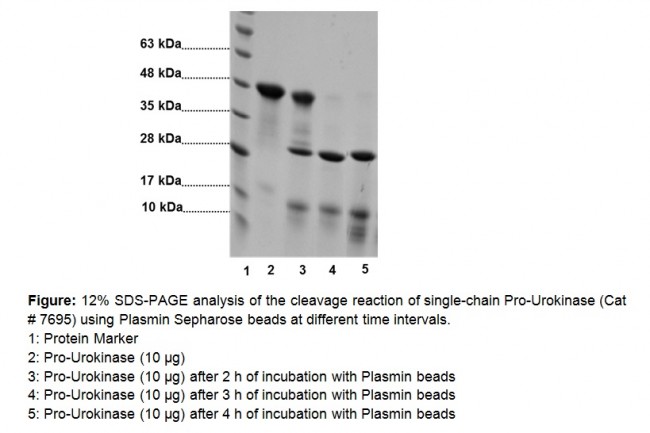Description
Plasmin is a serine protease which cleaves polypeptide chains after arginyl and Iysyl residues. In addition to cleavage of fibrin, plasmin also catalyzes activation and/or degradation of compounds of the coagulation, kinin generation and complement systems. Plasmin Sepharose beads are designed for efficient cleavage and activation of various proteins containing a plasmin cleavage site, circumventing the need for chromatographic techniques to remove plasmin after completion of the cleavage reaction. BioVision’s Plasmin Sepharose is prepared by covalent coupling of bovine plasmin to activated 6% cross-linked Sepharose beads. 50 µl of the slurry is sufficient to cleave >90% of 1 mg of single-chain Pro-Urokinase (Cat # 7695) in 50 mM Tris buffer, 0.1 M NaCl, pH 7.4 within 3 h at 37°C. These beads can be regenerated for repeated use. The efficiency of reused beads depends on multiple criteria including previous usage, sample and handling of the beads.
Datasheet
| SKU-Size |
7926-1 (1 ml) 7926-5 (5 ml) 7926-25 (25 ml) |
| FORMULATION: Plasmin on 6% cross linked Sepharose beads, provided as 50% slurry in pure glycerol. LIGAND DENSITY: 0.2 mg/ml of the resin. APPLICATIONS: Efficient and convenient cleavage of recombinant fusion proteins containing plasmin-specific cleavage site. PROTOCOL: In order to find the optimum cleavage conditions for a target protein, it is recommended to run preliminary cleavage reactions at a small scale. Successful cleavage with plasmin is dependent upon proper folding of the target protein that enables access of the plasmin recognition sequence by the enzyme. Once optimum cleavage conditions are obtained, the reaction can be scaled up to cleave the entire amount of the target protein. The target protein should be purified to homogeneity and dialyzed against 50 mM Tris buffer, 0.1 M NaCl, pH 7.4 before setting up the cleavage reaction. 1) Resuspend the beads by gentle swirling. Do not vortex. 2) Aliquot 50 µl of the suspended slurry and add to 1 mg of the target protein in an Eppendorf tube. The recommended concentration of target protein is 1 mg/ml. 3) Mix gently by inverting the tube (do not vortex) and shake on a rotary shaker at 37°C 4) At regular time intervals spin down the tube to aliquot a test sample and freeze it immediately. At the end of the reaction, analyze the samples by SDS-PAGE. 5) To avoid excessive cleavage, do not incubate for longer periods. Recovery of the cleaved target protein: 1) After the fusion protein is completely cleaved, spin down the reaction mixture for 2-3 min at 1500 x g. 2) Remove the supernatant and wash the beads with 0.2 ml of 50 mM Tris buffer, pH 7.4. 3) Repeat steps 1 and 2 to maximize the recovery of the target protein and its cleaved fragment. Further chromatography may be necessary to remove the cleaved fragments from the target protein. | |
| Storage Conditions | -20°C |
|---|---|
| Shipping Conditions | Gel Pack |
| USAGE | For Research Use Only! Not For Use in Humans. |
FAQ
-
 We're here to help
We're here to help
Get expert recommendations for common problems or connect directly with an on staff expert for technical assistance related to applications, equipment and general product use.
Contact Tech Support
 High Quality Guaranteed Product
High Quality Guaranteed Product
Our products such as Elisa, Antibodies, Proteins, Peptides and sequencing kits are covered by Biolinkk quality warranty and will work as described in datasheet, a free replacement or money back is guaranteed if does not perform according to datasheet.
Learn More



